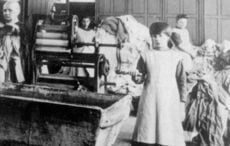Iconic artworks inspired by the anguish of the Great Hunger are being brought back to Ireland in 2018 for major exhibitions in Dublin and Cork.
The works from the collection of Quinnipiac University’s Ireland’s Great Hunger Museum will be unveiled at Dublin Castle in March 2018 before traveling to the West Cork Arts Centre for a four-month stay.
Brought together over a decade by Quinnipiac University President John Lahey, the collection from the permanent display at the Great Hunger Museum represents the most significant collection of Famine-related art in the world.
“‘Coming Home: Art and the Great Hunger will be an important act of cultural re-connection with Ireland’s past and living diaspora,” says Claire Puzarne, Assistant Director at Ireland’s Great Hunger Museum in Camden, CT. “This will be a major cultural, educational and tourist attraction featuring the powerful works of some of the most eminent Irish and Irish American artists of the past 170 years including Daniel McDonald, Lilian Davidson, Paul Henry, Michael Farrell, Rowan Gillespie and Alanna O’Kelly.”
The museum chose Dublin and Cork for the exhibition as “dramatic epicenters” of the Great Hunger which claimed two million lives from 1845-1852 and drove an additional two million out of Ireland. “To show this collection in Skibereen, described as ‘ground zero’ of the Famine, and Dublin Castle, where so little was done to alleviate the catastrophe, is particularly poignant.”
Total costs of the exhibition are believed to be around $800,000 with one quarter of that amount coming from Quinnipiac University and the remainder from fundraising.
Adds Puzarne: “The impact of the Great Hunger is still with us. It has shaped Ireland’s history, landscape, politics, culture and character. And the Irish diaspora defines Ireland’s place in the world. As a result of the Great Hunger, the Irish became a large part of American society. This makes Connecticut a fitting place to tell this story. ‘Coming Home: Art and the Great Hunger’ will allow Quinnipiac University to bring its collection home to share with the people of Ireland and allow new generations to understand the scale of the Famine, its horror, and how it permeated everything.”
Further details of the exhibition’s touring schedule in Ireland and donation options are available online at www.artandthegreathunger.com.




Comments